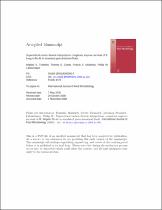JavaScript is disabled for your browser. Some features of this site may not work without it.
- ResearchSpace
- →
- Research Publications/Outputs
- →
- Journal Articles
- →
- View Item
| dc.contributor.author |
Thantsha, MS

|
|
| dc.contributor.author |
Cloete, TE

|
|
| dc.contributor.author |
Moolman, FS

|
|
| dc.contributor.author |
Labuschagne, Philip W

|
|
| dc.date.accessioned | 2009-04-24T13:42:38Z | |
| dc.date.available | 2009-04-24T13:42:38Z | |
| dc.date.issued | 2009-01 | |
| dc.identifier.citation | Thantsha, MS, Cloete, TE, Moolman, FS and Labuschagne, PW. 2009. Survival of B. longum Bb-46 in simulated gastrointestinal fluids. International Journal of Food Microbiology, Vol. 129(1), pp 1-18 | en |
| dc.identifier.issn | 0168-1605 | |
| dc.identifier.uri | http://hdl.handle.net/10204/3338 | |
| dc.description | Copyright: 2009 This is the author's version of the work. It is posted here by permission of Elsevier for your personal use. Not for redistribution | en |
| dc.description.abstract | Gastric acidity is the main factor affecting viability of probiotics in the gastrointestinal tract (GIT). This study investigated the survival in simulated gastrointestinal fluids of Bifidobacterium longum Bb-46 encapsulated in interpolymer complexes formed in supercritical carbon dioxide (scCO2). Bacteria were exposed sequentially to simulated gastric fluid (SGF, pH 2) for 2 h and simulated intestinal fluid (SIF, pH 6.8) for 6 or 24 h. Total encapsulated bacteria were determined by suspending 1 g of product in SIF for 6 h at 37 °C prior to plating out. Plateswere incubated anaerobically at 37 °C for 72 h. The interpolymer complex displayed pH-responsive release properties, with little to no release in SGF and substantial release in SIF. There was a limited reduction in viable counts at the end of exposure period due to encapsulation. Protection efficiency of the interpolymer complexwas improved by addition of glyceryl monostearate (GMS). Gelatine capsules delayed release of bacteria from the interpolymer complex thusminimizing time of exposure to the detrimental conditions. Use of poly (caprolactone) (PCL), ethylene oxide-propylene oxide triblock copolymer (PEO-PPO-PEO) decreased the protection efficiency of the matrix. Interpolymer complex encapsulation showed potential for protection of probiotics and therefore for application in food and pharmaceuticals | en |
| dc.language.iso | en | en |
| dc.publisher | Elsevier | en |
| dc.relation.ispartofseries | Manuscript | en |
| dc.subject | Probiotics | en |
| dc.subject | Interpolymer complex | en |
| dc.subject | Bifidobacterium longum Bb-46 | en |
| dc.subject | Supercritical CO2 | en |
| dc.subject | gastrointestinal fluids | en |
| dc.subject | Gastrointestinal tract | en |
| dc.subject | GIT | en |
| dc.subject | Microbiology | en |
| dc.subject | Plant pathology | en |
| dc.title | Survival of B. longum Bb-46 in simulated gastrointestinal fluids | en |
| dc.type | Article | en |
| dc.identifier.apacitation | Thantsha, M., Cloete, T., Moolman, F., & Labuschagne, P. W. (2009). Survival of B. longum Bb-46 in simulated gastrointestinal fluids. http://hdl.handle.net/10204/3338 | en_ZA |
| dc.identifier.chicagocitation | Thantsha, MS, TE Cloete, FS Moolman, and Philip W Labuschagne "Survival of B. longum Bb-46 in simulated gastrointestinal fluids." (2009) http://hdl.handle.net/10204/3338 | en_ZA |
| dc.identifier.vancouvercitation | Thantsha M, Cloete T, Moolman F, Labuschagne PW. Survival of B. longum Bb-46 in simulated gastrointestinal fluids. 2009; http://hdl.handle.net/10204/3338. | en_ZA |
| dc.identifier.ris | TY - Article AU - Thantsha, MS AU - Cloete, TE AU - Moolman, FS AU - Labuschagne, Philip W AB - Gastric acidity is the main factor affecting viability of probiotics in the gastrointestinal tract (GIT). This study investigated the survival in simulated gastrointestinal fluids of Bifidobacterium longum Bb-46 encapsulated in interpolymer complexes formed in supercritical carbon dioxide (scCO2). Bacteria were exposed sequentially to simulated gastric fluid (SGF, pH 2) for 2 h and simulated intestinal fluid (SIF, pH 6.8) for 6 or 24 h. Total encapsulated bacteria were determined by suspending 1 g of product in SIF for 6 h at 37 °C prior to plating out. Plateswere incubated anaerobically at 37 °C for 72 h. The interpolymer complex displayed pH-responsive release properties, with little to no release in SGF and substantial release in SIF. There was a limited reduction in viable counts at the end of exposure period due to encapsulation. Protection efficiency of the interpolymer complexwas improved by addition of glyceryl monostearate (GMS). Gelatine capsules delayed release of bacteria from the interpolymer complex thusminimizing time of exposure to the detrimental conditions. Use of poly (caprolactone) (PCL), ethylene oxide-propylene oxide triblock copolymer (PEO-PPO-PEO) decreased the protection efficiency of the matrix. Interpolymer complex encapsulation showed potential for protection of probiotics and therefore for application in food and pharmaceuticals DA - 2009-01 DB - ResearchSpace DP - CSIR KW - Probiotics KW - Interpolymer complex KW - Bifidobacterium longum Bb-46 KW - Supercritical CO2 KW - gastrointestinal fluids KW - Gastrointestinal tract KW - GIT KW - Microbiology KW - Plant pathology LK - https://researchspace.csir.co.za PY - 2009 SM - 0168-1605 T1 - Survival of B. longum Bb-46 in simulated gastrointestinal fluids TI - Survival of B. longum Bb-46 in simulated gastrointestinal fluids UR - http://hdl.handle.net/10204/3338 ER - | en_ZA |






